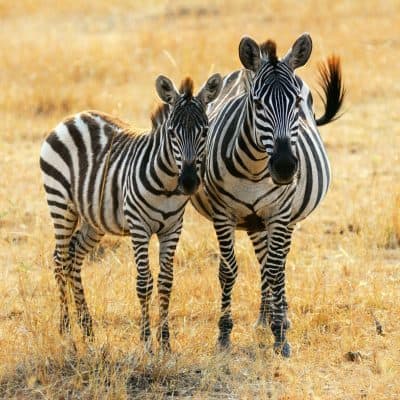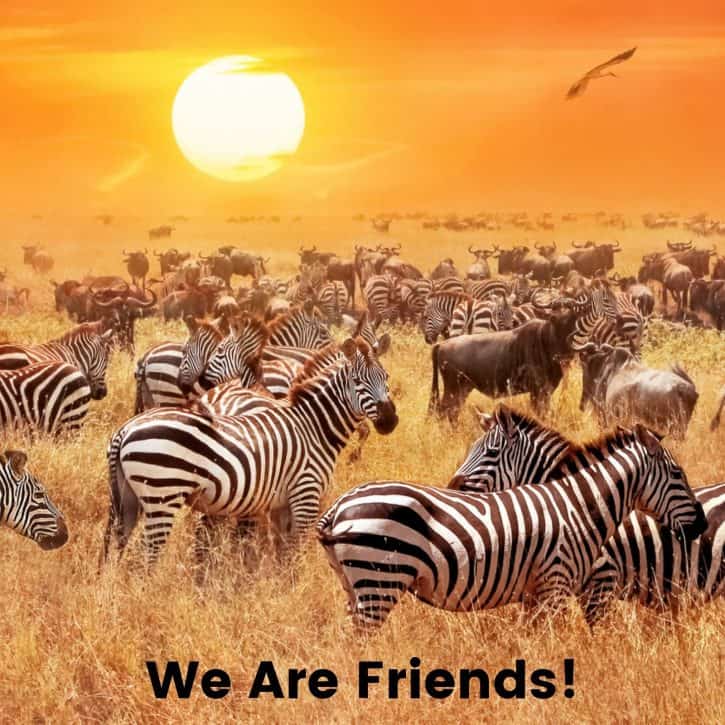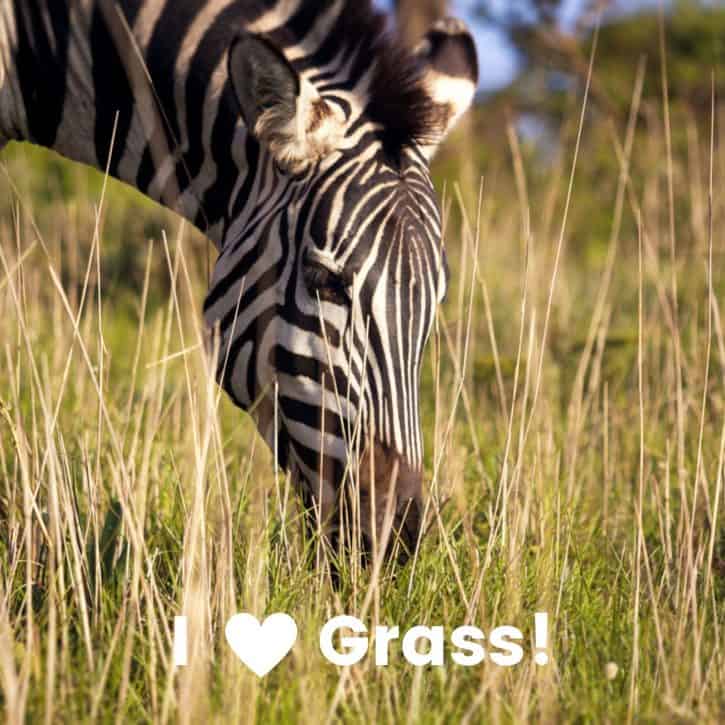What Do Zebras Eat?
May 21, 2020June 18, 2019 by C.B. Daniels


The Short Answer: Zebras are herbivores (plant eaters) that eat a variety of grasses. That being said, if they can’t find any suitable grass then they will also eat bark, flowers, herbs, leaves, legumes, roots, shrubs, and twigs.
To find out lots more about zebras and what they eat, read on.
Contents
2.1 How Do Zebras Get Their Food?
2.2 What Do Baby Zebras (Foals) Eat?
4 Other articles you might enjoy
What Are Zebras?
Now that we’ve got the short answer to “What do zebras eat?” out of the way, let’s deep dive into zebras and their diet.
Zebras are mammals from the family Equidae, which also includes horses and donkeys. They are native to Africa and are found in many different habitats from savannas to mountains.
Zebras are characterized by their thick bodies, tufted tails, short manes, and of course, their striking black and white patterns. In case you were curious, zebras are technically black with white stripes (as opposed to being white with black stripes).
There are three species of zebra: the plains zebra, the mountain zebra, and the Grevy’s zebra.
Both the plains and mountain zebra are part of the subgenus Hippotigris, and they are more similar in appearance to horses. Conversely, the Grevy’s zebra is part of the subgenus Dolichohippus and is more similar in appearance to a donkey.
- The plains zebra (also called the common zebra) is the most prevalent of the three species and is typically found in African savannas which are a type of ecosystem that includes trees and grasses that are not enclosed by canopies.
- The mountain zebra is the only species that has subspecies (it has two: the Cape mountain zebra and the Hartmann’s mountain zebra) and is typically found in, wait for it, mountainous regions. Specifically mountains in Angola, Namibia, and South Africa.
- The Grevy’s zebra (also called the imperial zebra) is the largest of the zebras and is typically found in semi-arid grasslands in Kenya and Ethiopia.
Zebras can live up to 25 years, can weigh up to 990 lbs. (although typically they weigh closer to 770 lbs.), and can reach speeds of up 40mph.
Fun Fact: Zebra stripe patterns are unique, and no two zebras have the same pattern.
What Do Zebras Eat?
Zebras are herbivores, which means that they eat plants. Specifically, zebras prefer to eat different types of grasses. In fact, 90% of their diet consists of grass.
Due to the climate in Africa (there is often a severe lack of water which is known as a drought), zebras have evolved to be able to survive on very low-nutrient plants. This is as opposed to other herbivores who need higher-nutrient plants (like cows).
So, while many herbivores would not be able to survive on dried-out grasses, zebras can.
This is because they have a specialized digestion system that enables them to digest plant matter more thoroughly than most other herbivores.
The main process that helps them do this is called hindgut fermentation, which is where animals with single-chambered stomachs have beneficial bacteria that help break down plant fiber.
Other animals that utilize hindgut fermentation are horses, rabbits, and rhinoceroses.
This is unique because most herbivores have multiple stomachs to help them break down plant material and use foregut fermentation where they ferment their food in a specialized stomach before they start the digestion process.
Some animals that utilize foregut fertilization are cows, goats, sheep, and deer.
Their specialized digestion allows zebras to live off not only dried-out grasses, but twigs, leaves, roots, and bark as well.
How Do Zebras Get Their Food?
Zebras spend much of their day grazing (aka eating grass). In fact, they spend 60-80% of their day eating. That is a lot of effort just to get some food!
This is because zebras often eat low-nutrient food. Since their food is not very nutritious, they must compensate by eating large quantities of it to survive. Zebras also need lots of water and prefer to drink water daily (however they can go up to 3-5 days without water if they must).
Fun Fact: Zebras can drink up to one gallon of water at a time.
Zebras will often gather together in large herds to look for food and water. They will also often group with other grazers such as wildebeests and antelopes.

Zebras can travel hundreds of miles in search of food and water. They often follow rain or riverbeds when they are searching.
As mentioned earlier, zebras have specialized digestion that helps them eat lots of grass. But they also have incredibly strong teeth, which also helps them eat.
Zebras have sharp incisors to help them cut grass and large, strong molars that help them to grind and chew grass.
Fun Fact: Zebra’s teeth never stop growing, which is a good thing considering all the chewing they do!
What Do Baby Zebras (Foals) Eat?

Baby zebras are called foals and they have a different diet than adult zebras do.
Since zebras are mammals, foals drink their mother’s milk during their first year while they are nursing. They are then weaned onto regular adult food, i.e. grasses.
Zebras reproduce year-round like humans. Female zebras are called mares, and male zebras are called stallions.
Even though they can reproduce year-round, most zebras mate during rainy seasons because mares will often come into heat when food is plentiful (which is when water is abundant).
Also, there are some peak times for breeding.
Plains zebras and Grevy’s zebras will often mate August to October, and mountain zebras will often mate December to February.
While most zebras travel in herds, Grevy’s zebras are the exception.
Plains zebras and mountain zebras live in harems (where you have one stallion and several mares), while Grevy’s zebras travel individually and only group together for a couple of months at a time (often for reproduction).
All species of zebra have bachelor herds which are all male herds.
So, this means that plains zebras and mountain zebras have bachelor herds as well as harems, while Grevy’s zebras have some bachelor herds as well as individuals (and the females are not in herds at all).
Female zebras gestate for about 12-13 months. They give birth to one foal at a time like horses do and they nurse for about one year after the foal is born.
Just like horses, baby zebras can stand and walk almost immediately after they are born.
After giving birth, female zebras keep other zebras away for several days until their foal recognizes them (this is called imprinting).
After a couple of days have passed, the foal is introduced to and protected by the herd, except for Grevy’s zebras who are protected only by their mother (since they do not stay in herds).
When male foals are between 1-3 years old, they are considered adults. This is when they can choose to leave either their mother or the harem (depending on the species) and often join a bachelor heard until they can either compete for females or go off on their own.
Fun Fact: Baby zebras are born with brown and white stripes instead of black and white (they change to black and white by the time they are six months old).
What Do Adult Zebras Eat?
Adult zebras are herbivores that prefer eating grass. However, if grass is not readily available, then they will also eat bark, flowers, herbs, leaves, legumes, roots, shrubs, and twigs.
Let’s take a closer look at what types of grass the different zebra species prefer.
- Plains zebras prefer short, young grasses and are highly dependent on water. They often eat red oat grass, African foxtail grass, Bermuda grass, and saw-tooth love grass (yes that is a real grass name).
- Grevy’s zebras prefer coarse grasses and are less dependent on water than the other zebra species. They often eat goosegrass and fountaingrass (who names these grasses!).
- Mountain zebras prefer tufted grasses and often use their hooves to dig for water since they live in mountainous regions. They often eat red oat grass, black speargrass, bottlebrush grass, and turpentine grass (these names are not getting better).
Zebra Food Options
- African Foxtail Grass
- Bark
- Bermuda Grass
- Black Speargrass
- Bottlebrush Grass
- Flowers
- Fountaingrass
- Goosegrass
- Herbs
- Leaves
- Legumes
- Red Oat Grass
- Roots
- Saw-tooth Love Grass
- Shrubs
- Turpentine Grass
- Twigs
Summary

Zebras are herbivores (plant eaters) that eat a variety of grasses.
The three species of zebra are the plains zebra, the mountain zebra, and the Grevy’s zebra.
Zebras have a specialized digestion system that enables them to digest plants more thoroughly than most other herbivores.
The main process that helps them digest is called hindgut fermentation, which is where animals with single-chambered stomachs have beneficial bacteria that help break down plant fiber.
Zebras spend much of their day grazing (aka eating grass). Zebras also have sharp incisors to help them cut grass and large, strong molars to help grind and chew grass.
Baby zebras are called foals and drink their mother’s milk for the first year of their life.
Female zebras are called mares, and male zebras are called stallions.
Zebras often travel in herds, and all species of zebra have bachelor herds which are all male herds.
Plains zebras and mountain zebras have bachelor herds as well as harems (where one male has many females), while Grevy’s zebras have some bachelor herds, and some individuals (and the females are not in herds at all).
Plains zebras prefer short, young grasses and are highly dependent on water
Grevy’s zebras prefer coarse grasses and are less dependent on water than the other zebra species.
Mountain zebras prefer tufted grasses and often use their hooves to dig for water since they live in mountainous regions.
Other articles you might enjoy
Hi my name is C.B. Daniels and I make websites. I’ve also always been fascinated by animals. I thought that some of the information about animal diets and pet names was a little thin. So I figured I’d make this site to remedy that! I hope to make this site a hub for information about what animals eat, fun names you can use for your pets, and general animal information. Hopefully, you’ll find all the information about animals you are looking for and much more!
Latest posts by C.B. Daniels (see all)
- Can Rabbits Eat Grapes? - November 12, 2022
- Can Rabbits Eat Cucumbers? - November 3, 2022
- Can Rabbits Eat Spinach? - November 3, 2022